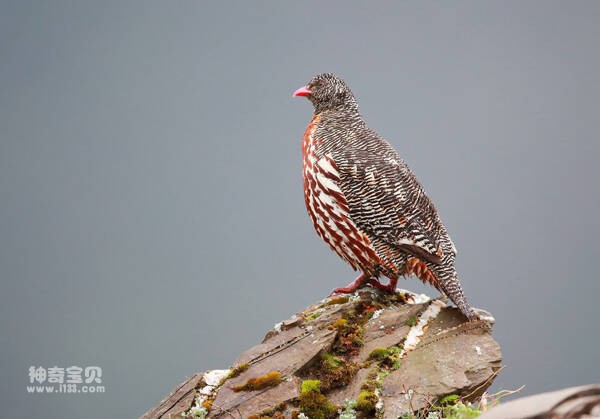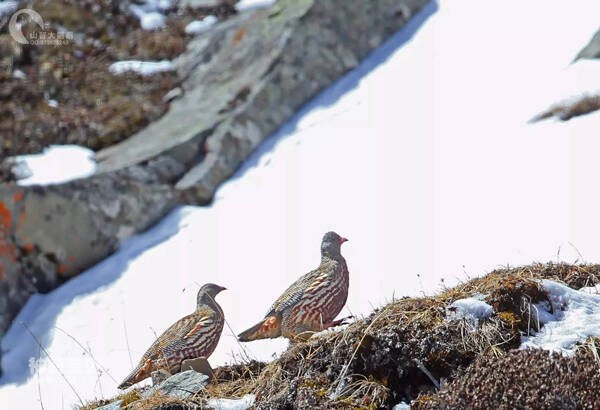Snow Partridge
IUCN
LCBasic Information
Scientific classification
- name:Snow Partridge
- Scientific Name:Snow Partridge,Lerwa lerwa
- Outline:Landfowl
- Family:Chickeniformes P.family S.Genus
Vital signs
- length:34-40cm
- Weight:About 560g
- lifetime:No textual research information is available
Feature
The body feathers are mostly black and white, or black and brown mixed stripes
Distribution and Habitat
Snow quail is a typical alpine species living in the Himalayan region, distributed in the Tibetan Plateau of China and neighboring Nepal, northern India, Kashmir and Afghanistan and other countries and regions.
The natural environment is extremely harsh, and most of them live in alpine scrub, alpine meadows and bare rock areas between 3000-5500 meters above sea level. It is often found on rocky steep slopes with alpine plants such as rhododendrons, ferns, mosses, lichens, etc. In summer, it is mostly in rocky areas above 4000 meters above sea level, and in winter, it drops to about 4000-3000 meters, or even 2000 meters. From Lijiang to Longshan in Yunnan Province, it was also seen in January at an altitude of 4700-4800 meters.
Appearance
The head, neck and upper body of the snow quail have fine black and yellow white alternating stripes, the back more brown chestnut, especially on the shoulders; The tail is black and white stripes, and the width of the black stripes and white stripes is almost equal. The wing coverts and primary flight feathers are dark brown, and the third primary coverts are covered with white spots inside and outside the primary coverts; The secondary fly feathers and the large cover feathers are black and yellow alternating stripes; Secondary feathers with broad white tip spots; The tertiary flight feathers and the middle and small wing coverts and backs are identical. The lower body is chestnut, with white spots on the abdomen and flanks; The undertail coverts are also maroon with white tips.
Iris red or blood red, mouth coral red, tarsus and toe orange-red to deep red.
Size measurement: Weight 560 grams; Body length 340-400 mm; Rostral peak 18-28 mm; Wing 179-205 mm; Tail 118-138 mm; Tarsus
Details
Snow Partridge (Lerwa lerwa) has three subspecies.

Snow quails are good at walking and gliding, and often slide from one hill to another when they encounter enemies. As he walked on the ground he seemed to waddle, to stagger, to be ridiculously awkward. Their feather color is consistent with the surrounding environment, forming a good protective color, plus the mountain area is often foggy, and most of the communication between each other by calling, so often only hear its sound, not see its trace. The sound of the snow quail is thin and short, and the sound of the male bird is continuous, accelerating and increasing in pitch; The female has a deeper call and calls less often.
Snow quails are very adaptable to the natural conditions of the mountains, and their daily activity generally has two peaks, one in the early morning and one in the evening. Except during the breeding period, it is an integrated group activity. Not afraid of people, sometimes people can get very close. When startled, it flies away immediately, making a rapid, high-pitched cry as it takes off. It feeds on the ground, and the food has more than 40 kinds of mosses, ferns, herbs and shrubs, leaves, buds, flowers and seeds, and a very small amount of animal food, and pecks at some gravel.

From April to May each year, snow quails begin to group, pair, and mate, and nest in caves under cliffs and rocks or in shrubs and weeds. The nest is very hidden, made of grass stems and moss. Each litter lays 2-5 eggs, up to 7 eggs. The egg is milky white or dark yellow in color, densely covered with reddish dots and patches. The average size is 48.2-51.8×37.7-39.3 mm, and the average weight is 35.4-36 grams. Brooding is done by the female.
The population of snow quail varies greatly with the different distribution areas, but the total number is still relatively large. It is abundant in the core of its distribution area. However, it is rare in southern Gansu and northwestern Yunnan of China, which are at the edge of the distribution area. Due to the increasing economic activities of local residents in the high mountain areas, the survival of snow quails is also under increasing threat. In addition, low clutch number and poor habitat environment are also the main reasons limiting the development of snow quail population.
Listed on the International Union for Conservation of Nature (IUCN) 2016 Red List of Threatened Species ver3.1 - Not Threatened (LC).
Protect wild animals and eliminate wild meat.
Maintaining ecological balance is everyone's responsibility!








